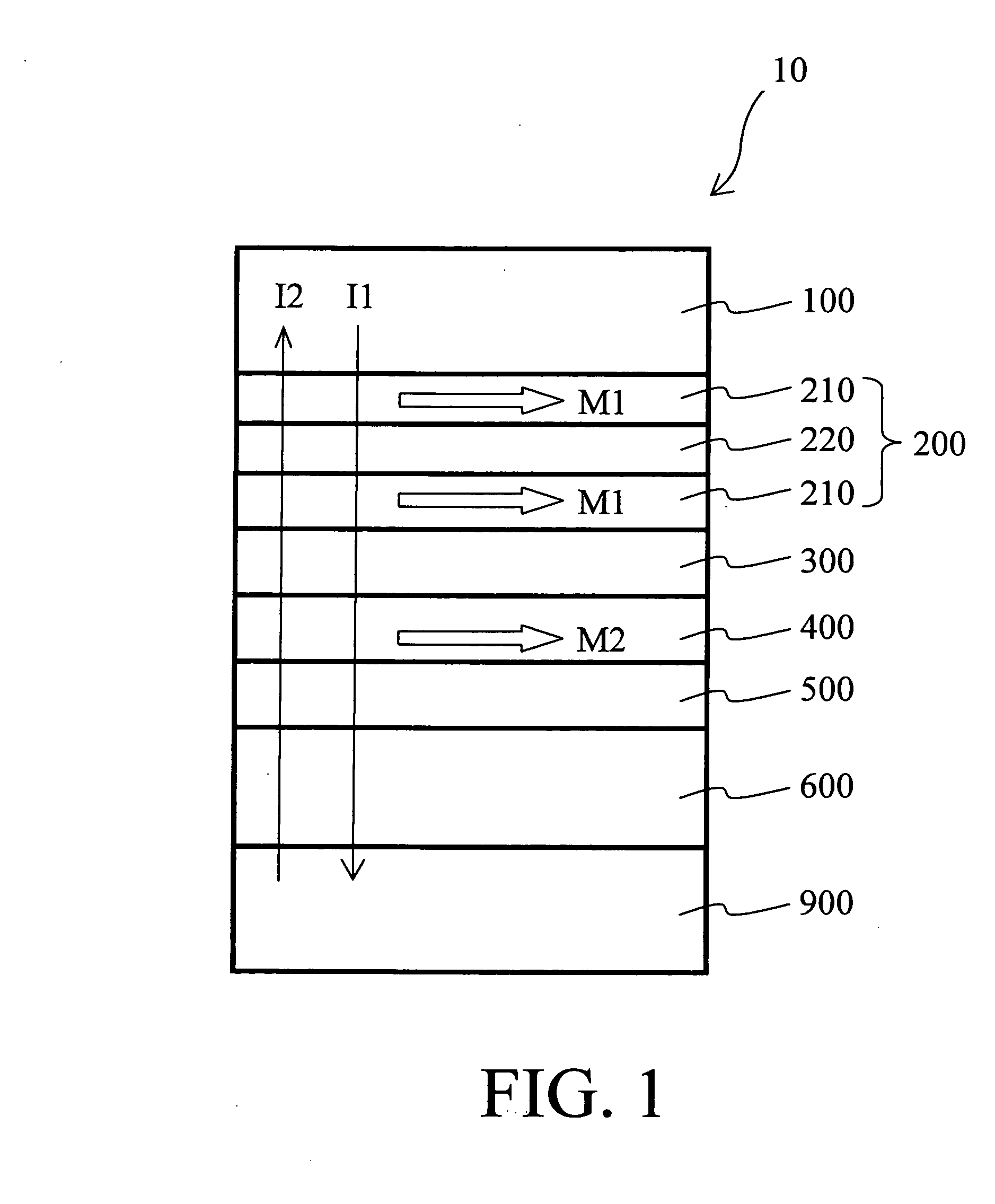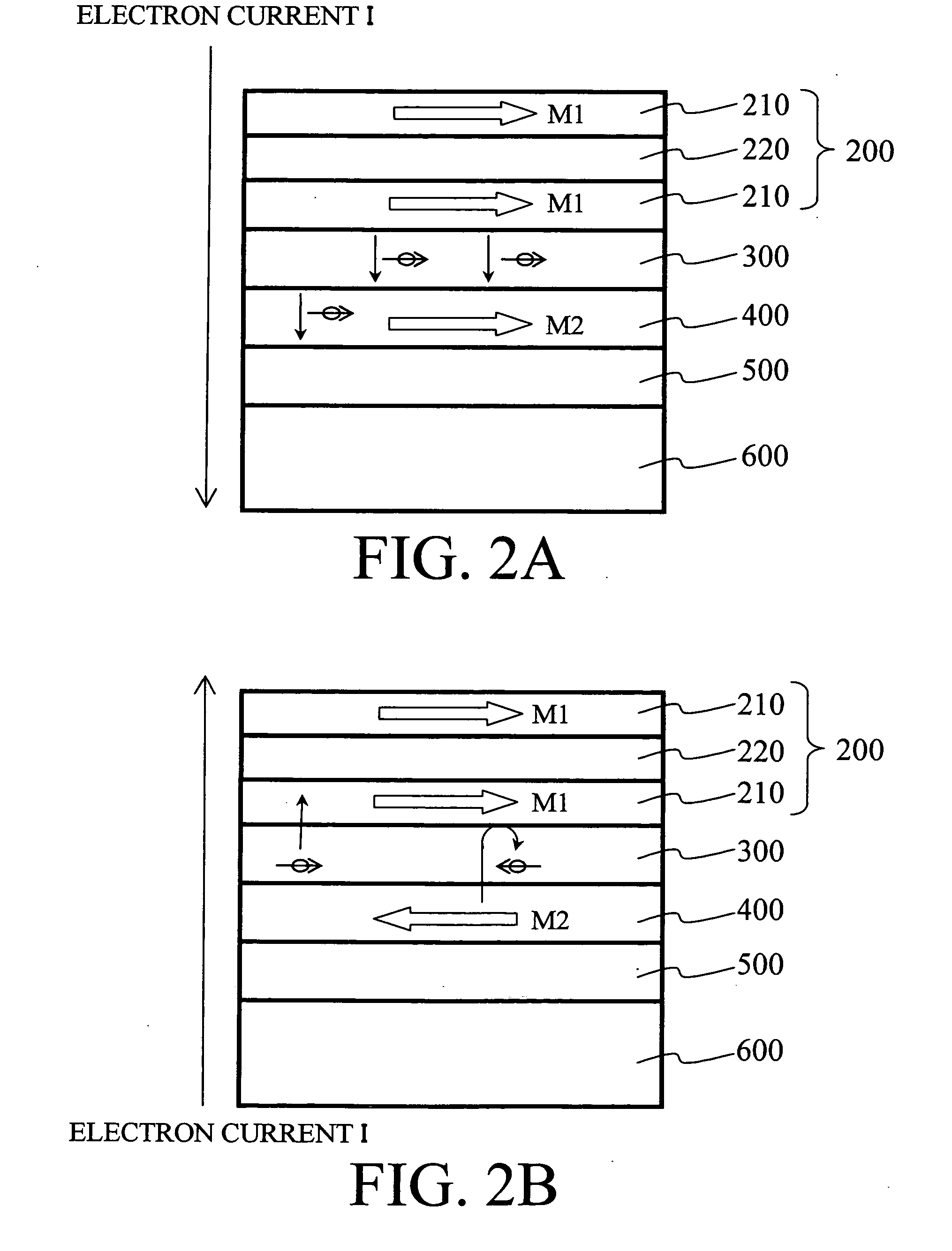Magnetic device and magnetic memory
a magnetic memory and magnetic field technology, applied in the field of magnetic devices and magnetic memory, can solve the problems of difficult localization of magnetic fields, insufficient magnetic field generation, and high reversal current for reversing magnetization
- Summary
- Abstract
- Description
- Claims
- Application Information
AI Technical Summary
Benefits of technology
Problems solved by technology
Method used
Image
Examples
first embodiment
[0083]FIG. 1 is a schematic view illustrating a basic cross-sectional structure of a magnetic device according to a first embodiment of the invention. The magnetic device 10 is configured such that a first pinned layer 200, first intermediate layer 300, free layer 400, second intermediate layer 500 and second pinned layer 600 are stacked between a couple of electrodes 100 and 900 configured to provide write current between the first and second ferromagnetic layers to cause spin-polarized electrons to act on the third ferromagnetic layer so that the direction of magnetization of the third ferromagnetic layer is determined depending on a direction of the current.
[0084] The first pinned layer 200 comprises a multilayer film in which at least two magnetic layers are ferromagnetically coupled with each other. Each of these magnetic layers has an easy axis of magnetization substantially parallel to the film plane. The multilayer film is composed of (magnetic layer 210 / nonmagnetic layer 2...
second embodiment
[0138] Next, as a second embodiment of the invention, a magnetic device will be described in which the free layer 400 is multilayered.
[0139]FIG. 15 is a schematic view illustrating a basic cross-sectional structure of a magnetic device according to a second embodiment of the invention. In this figure, the same elements as those previously described with reference to FIGS. 1 to 14 are given the same reference numerals and not described in detail.
[0140] In this embodiment, the free layer 400 is configured as a multilayer film composed of (magnetic layer 410 / nonmagnetic layer 420)×N / magnetic layer 410 (N=1 or greater) that are ferromagnetically coupled. That is, the free layer 400 is configured such that magnetic layers 410 and nonmagnetic layers 420 are stacked alternately with each other, and that magnetic layers 410 are ferromagnetically coupled with each other via a nonmagnetic layer 420 having a enough coupling strength such that the magnetization of the free layer 400 rotates m...
third embodiment
[0154] Next, as a third embodiment of the invention, a magnetic device will be described in which the first pinned layer 200 and the free layer 400 are each multilayered.
[0155]FIG. 17 is a schematic view illustrating a basic cross-sectional structure of a magnetic device according to a third embodiment of the invention. In this figure again, the same elements as those previously described with reference to FIGS. 1 to 16 are given the same reference numerals and not described in detail.
[0156] In this embodiment, the first pinned layer 200 and the free layer 400 are each configured as a multilayer film composed of (magnetic layer / nonmagnetic layer)×N / magnetic layer (N=1 or greater) that are ferromagnetically coupled. That is, the first pinned layer 200 is configured such that magnetic layers 210 and nonmagnetic layers 220 are stacked alternately with each other, and that at least two of the magnetic layers 210 are ferromagnetically coupled via a nonmagnetic layer 220. Likewise, the ...
PUM
| Property | Measurement | Unit |
|---|---|---|
| thickness | aaaaa | aaaaa |
| reversal current | aaaaa | aaaaa |
| thickness | aaaaa | aaaaa |
Abstract
Description
Claims
Application Information
 Login to View More
Login to View More - R&D
- Intellectual Property
- Life Sciences
- Materials
- Tech Scout
- Unparalleled Data Quality
- Higher Quality Content
- 60% Fewer Hallucinations
Browse by: Latest US Patents, China's latest patents, Technical Efficacy Thesaurus, Application Domain, Technology Topic, Popular Technical Reports.
© 2025 PatSnap. All rights reserved.Legal|Privacy policy|Modern Slavery Act Transparency Statement|Sitemap|About US| Contact US: help@patsnap.com



